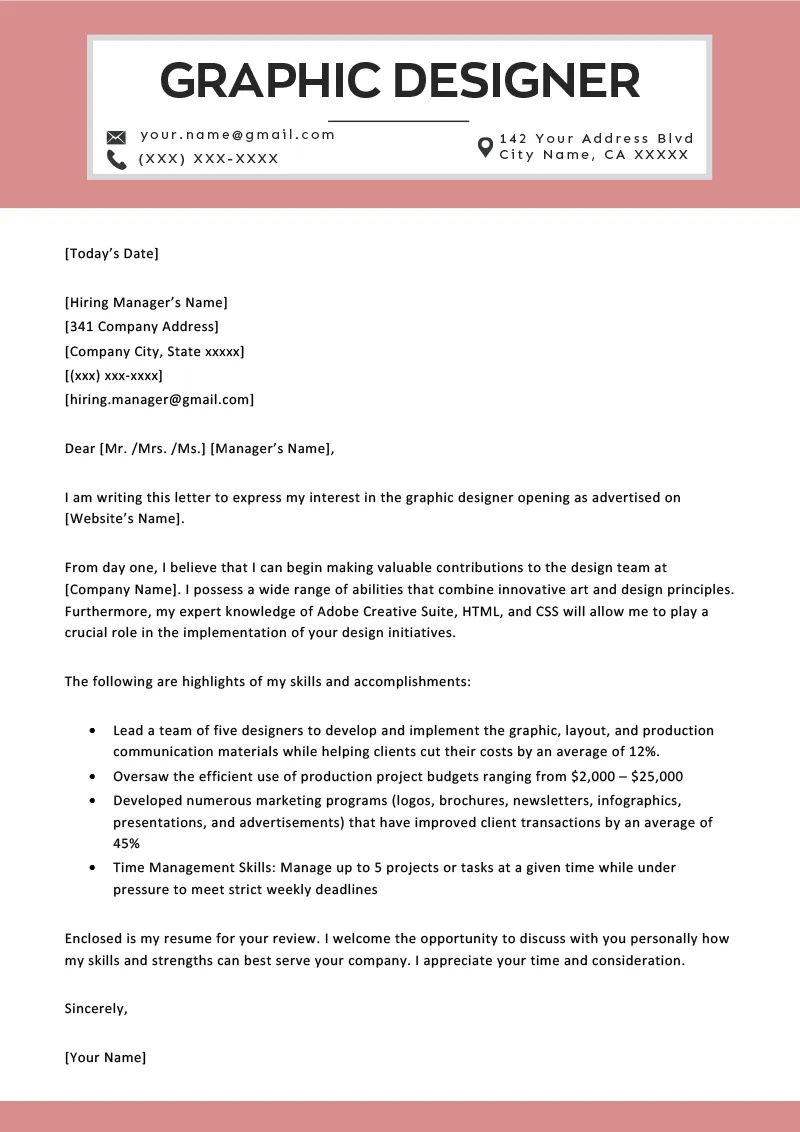What is a Graphic Designer Cover Letter?
A graphic designer cover letter is a crucial document that accompanies your resume when applying for a graphic design position. It’s your first opportunity to introduce yourself to a potential employer, showcase your personality, and highlight your qualifications. Think of it as a personalized advertisement of your skills and experiences, tailored specifically for the job you are applying for. Unlike a resume, which provides a factual overview, a cover letter allows you to tell a story, explain your passion for design, and connect with the hiring manager on a more personal level. It is a chance to demonstrate how your skills and experience align with the specific requirements of the role and the company’s values.
Why is a Cover Letter Important?
In the competitive world of graphic design, a cover letter can be the deciding factor in whether your application gets noticed. It provides an opportunity to differentiate yourself from other applicants by demonstrating your unique skills, creativity, and enthusiasm. Many hiring managers consider a cover letter essential because it reveals your communication skills, attention to detail, and your genuine interest in the position. It shows that you’ve taken the time to research the company and understand their needs. A well-crafted cover letter can significantly increase your chances of securing an interview and ultimately landing your dream job. It is an opportunity to provide context to your resume, explaining why you are the perfect fit for this specific role.
Essential Components of a Graphic Designer Cover Letter
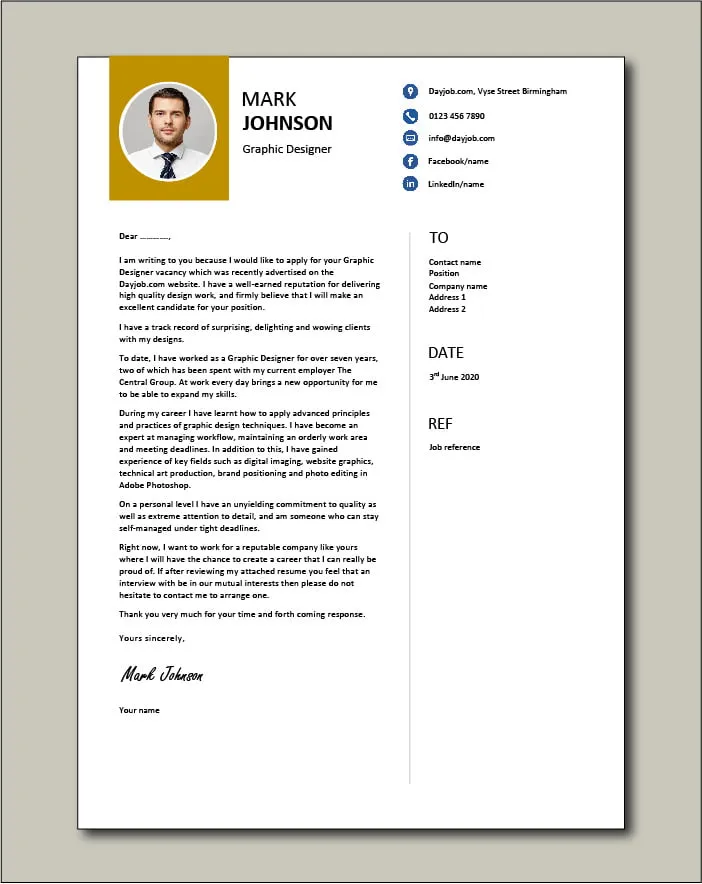
A compelling graphic designer cover letter consists of several key components that work together to make a strong impression. Each section plays a vital role in conveying your qualifications and enthusiasm. By carefully crafting each part, you can create a cover letter that effectively highlights your strengths and secures you an interview. These components ensure you are providing the right information in the right order, showcasing your expertise and personality.
Contact Information
Start with your contact information at the top, including your name, phone number, email address, and optionally, your LinkedIn profile or personal website URL. Make sure this information is up-to-date and professional. This section allows the hiring manager to easily reach you if they are interested in your application. Ensuring accuracy here is essential; a single typo could prevent them from contacting you.
Greeting
Address the hiring manager directly by name whenever possible. Research the company website or LinkedIn to find out who is in charge of hiring. If you can’t find a specific name, use a professional greeting such as “Dear Hiring Manager.” Avoiding generic greetings like “To Whom It May Concern” can make a better first impression. Addressing the recipient by name shows you’ve taken the time to research and personalize your application.
Opening Paragraph Hook
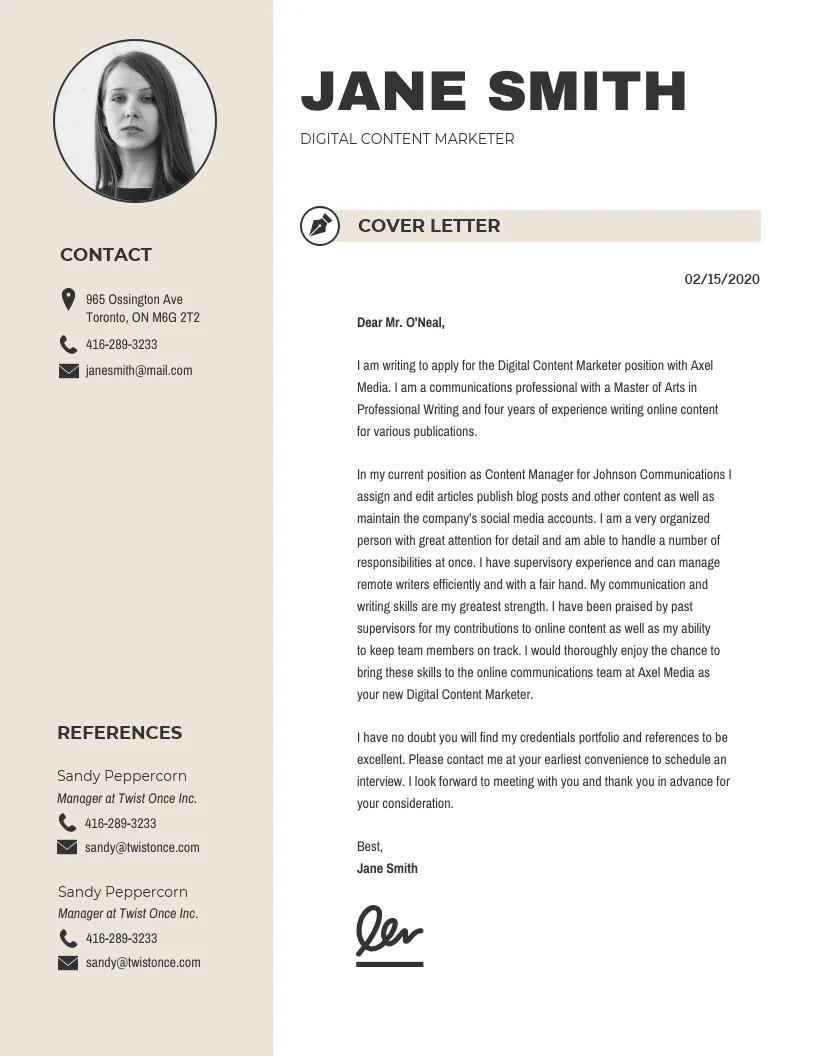
Your opening paragraph is your chance to grab the reader’s attention. Briefly state the position you are applying for and express your interest in the company. You can also include a brief statement about why you are excited about the opportunity or something that highlights your relevant experience. Make sure it’s concise, compelling, and immediately demonstrates your value. A strong opening sets the tone for the rest of the letter and encourages the reader to continue reading.
Highlighting Your Skills and Experience
This is where you showcase your relevant skills and experience. Describe your key accomplishments and how they align with the job requirements. Use specific examples to demonstrate your abilities, such as a project you led, a problem you solved, or a design challenge you overcame. Quantify your achievements whenever possible, using data to illustrate your impact (e.g., “Increased website traffic by 20%”). Tailor this section to match the job description, focusing on the skills and experience that are most relevant to the role.
Showcasing Your Portfolio
Graphic design is a visual field, so your portfolio is crucial. Mention your portfolio in your cover letter and provide a link to your online portfolio or a description of your best work. Highlight a few projects that are most relevant to the job. Explain your role in each project, the challenges you faced, and the outcomes you achieved. If you don’t have a website, consider creating a simple online portfolio using platforms like Behance or Dribbble. Make it easy for the hiring manager to access and review your work.
Expressing Enthusiasm and Fit
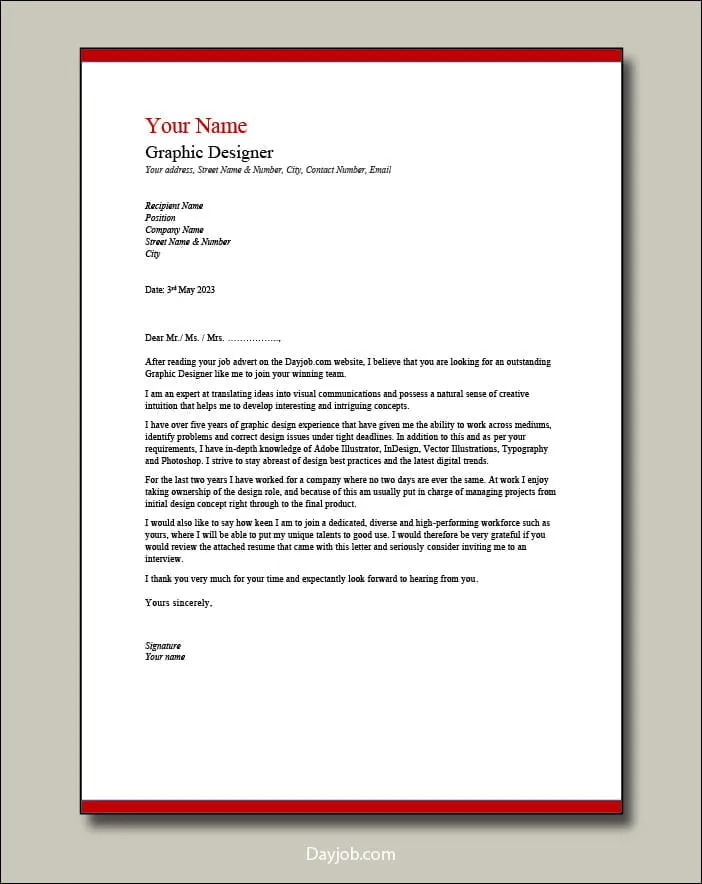
Show your genuine interest in the company and the position. Explain why you are excited about the opportunity and what attracts you to the company’s mission or values. Demonstrate that you have researched the company and understand their work. Explain how your skills and values align with the company culture. This shows that you’re not just looking for a job but that you’re genuinely interested in becoming a part of their team and making a contribution to their success.
Call to Action
Conclude your cover letter with a clear call to action. Express your eagerness to discuss your qualifications further and reiterate your interest in the position. Thank the hiring manager for their time and consideration. Provide a way for them to contact you, such as your phone number or email address. Make it easy for them to move forward with the hiring process and schedule an interview. A strong call to action encourages them to take the next step.
Formatting and Design Tips
Since you are a graphic designer, your cover letter’s design and formatting are just as important as its content. A well-designed cover letter showcases your design skills and attention to detail. This also demonstrate your understanding of design principles and your ability to present information visually. Following these tips will help you make a positive impression and grab the hiring manager’s attention. It will set you apart from other applicants.
Choosing the Right Template
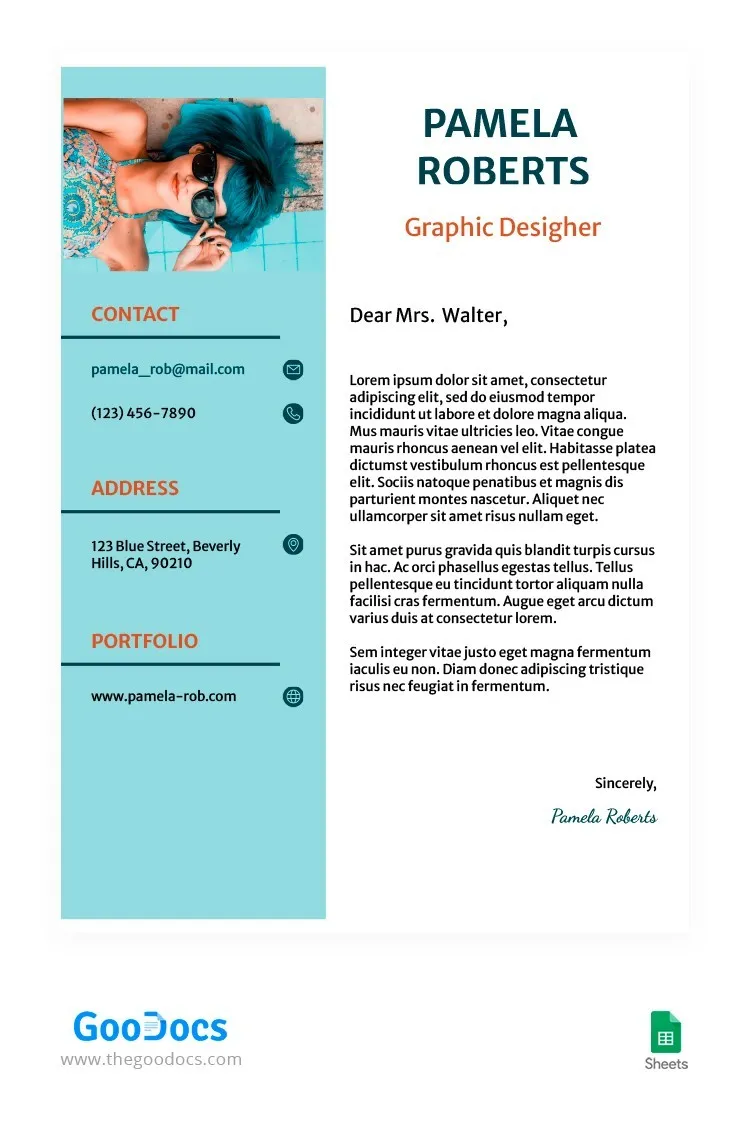
Select a professional and visually appealing cover letter template. There are many free and paid templates available online. Choose one that complements your design style and the type of company you are applying to. Ensure the template is easy to read and well-organized. Avoid templates that are too busy or distracting. The design should enhance your message, not detract from it. Ensure your template is also ATS-friendly, meaning it can be read by applicant tracking systems.
Fonts and Readability
Choose a clean, easy-to-read font, such as Arial, Helvetica, or Calibri. Keep the font size between 10 and 12 points for the body text. Use bold and italic fonts sparingly to highlight key information. Use consistent spacing and alignment to create a visually balanced layout. White space is your friend: it makes the document easier to read and prevents it from looking cluttered. Your cover letter should look professional and be easy on the eyes.
Proofreading and Editing
Proofread your cover letter carefully for any grammatical errors, spelling mistakes, or typos. Errors can damage your credibility and give the impression that you are not detail-oriented. Read the cover letter aloud to catch any awkward phrasing or sentences. Have a friend or colleague review your cover letter for feedback. Pay close attention to your tone and ensure it’s professional and enthusiastic. Using grammar and spell-check tools will also help catch any potential mistakes. Ensure your content is easy to understand and error-free.
Tailoring Your Cover Letter
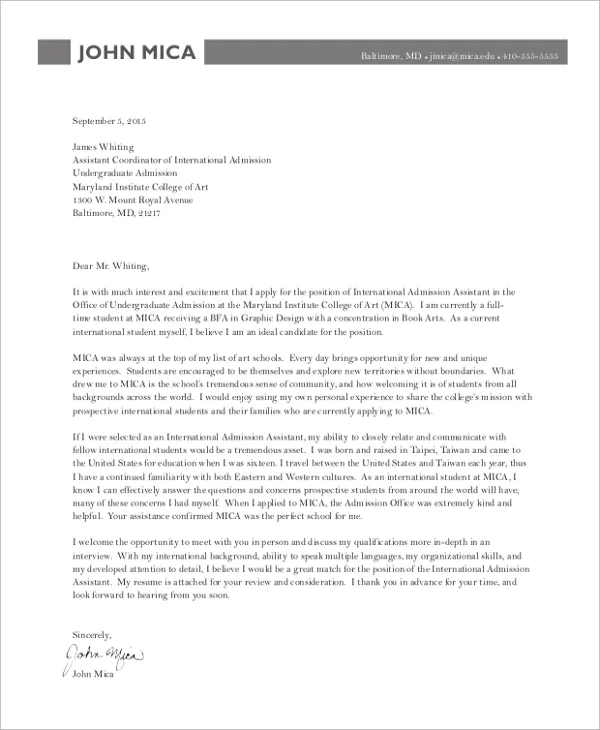
One of the most critical steps in writing a successful cover letter is tailoring it to each job application. Sending a generic cover letter will likely lead to rejection. Personalized cover letters show employers that you are genuinely interested in their company and the specific role. They also allow you to highlight the skills and experiences that are most relevant to the job description. A tailored cover letter shows you’ve done your research and are serious about the opportunity.
Researching the Company
Before writing your cover letter, thoroughly research the company. Visit their website, read their “About Us” section, and check out their social media profiles. Understand their mission, values, and recent projects. Tailor your cover letter to reflect your understanding of their brand and needs. Show the hiring manager that you are interested in more than just a job; you are interested in contributing to their success. This research will help you align your skills and goals with the company’s.
Customizing for the Job
Carefully review the job description and identify the key requirements and skills. Highlight the skills and experiences that match the job requirements, using specific examples from your past projects. Customize your cover letter to reflect the language and terminology used in the job description. This shows that you have the skills and experience the employer is looking for. Avoid a generic cover letter and tailor your content for each application. This approach greatly increases your chances of being noticed.
Graphic Designer Cover Letter Template Examples
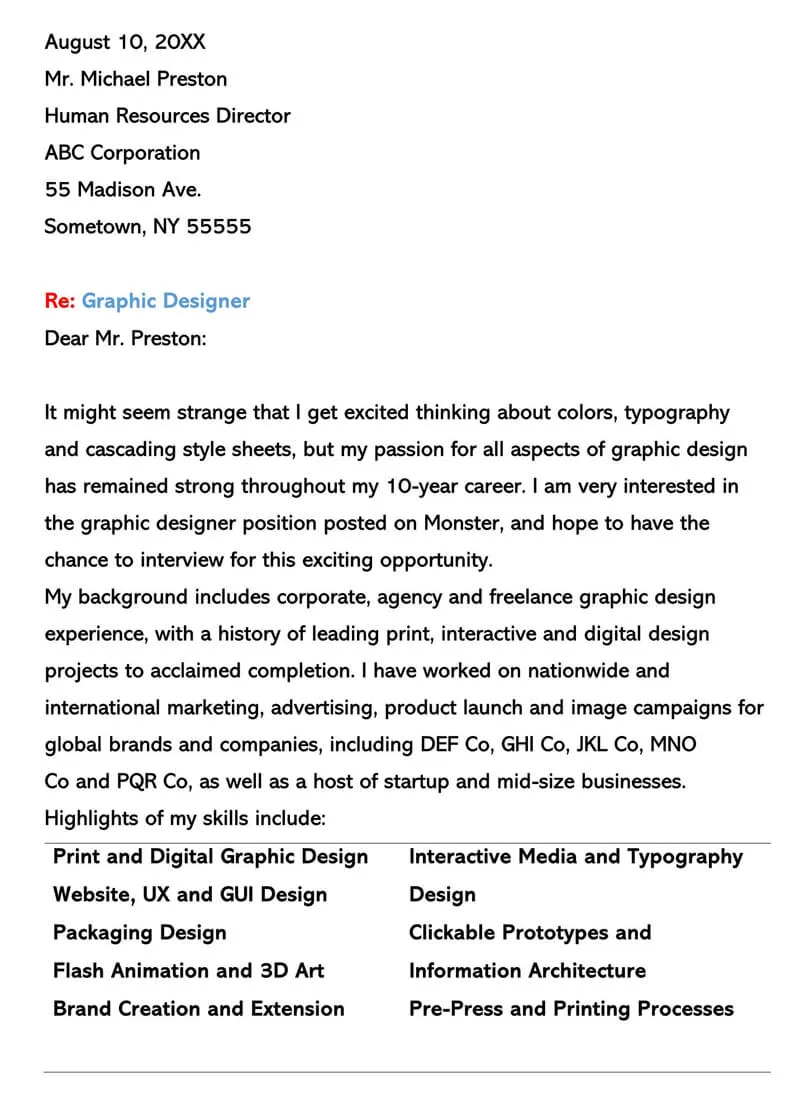
Using a template can save you time and ensure you include all the essential elements of a great cover letter. Numerous templates are available online, from basic formats to more creative designs. Choose a template that aligns with your design style and the type of company you are applying to. Always customize the template to reflect your personality and experiences. Here are a couple of examples to give you inspiration.
Example Template 1
This example template focuses on a clean, modern design, highlighting key skills and experiences. It typically includes your contact information, a personalized greeting, an opening paragraph that grabs the reader’s attention, a section that showcases your skills and experience with specific examples, a section for showcasing your portfolio, an expression of enthusiasm and fit for the company, and a clear call to action. The template provides a structured format that allows you to present your qualifications in a professional and organized manner. The design should be simple and easy to read, making a strong impression while effectively conveying the necessary information.
Example Template 2
This example template offers a more creative approach, allowing you to incorporate your design skills. It often includes a visually appealing layout with the use of color and imagery. The template includes all the essential components of a cover letter, but with a focus on visual elements. It provides sections for your contact information, a customized greeting, and a hook to grab the hiring manager’s attention. The emphasis is on your skills and experience, your portfolio, and an expression of enthusiasm for the company, with a clear call to action. The design can be tailored to match your brand, highlighting your creativity and attention to detail.
Common Mistakes to Avoid

Avoiding common mistakes can significantly improve the effectiveness of your graphic designer cover letter. Many applicants make errors that can hurt their chances of getting an interview. By being aware of these mistakes and taking steps to avoid them, you can present yourself as a polished and professional candidate. This increases your credibility with the hiring manager and show your understanding of the industry. Always double-check every aspect of your cover letter to be sure.
Grammar and Spelling Errors
Grammar and spelling errors can damage your credibility and make you appear unprofessional. Always proofread your cover letter carefully. Use a grammar checker to catch any mistakes you might miss. Ensure you use correct punctuation, capitalization, and sentence structure. These errors can make the hiring manager think you aren’t detail-oriented or that you lack communication skills. A well-written cover letter will make a positive impression.
Generic Language
Avoid using generic language that could apply to any job. Tailor your cover letter to each specific position and company. Show that you understand the company’s needs and how your skills can contribute to their success. Make sure you’re using a tone of voice that is appropriate for the company and the role. Generic cover letters don’t demonstrate that you have taken the time to learn about the company, which shows a lack of genuine interest. Instead, customize the language to convey a genuine interest.
Length and Brevity
Keep your cover letter concise and to the point. Aim for a single page. Avoid rambling or including unnecessary information. Focus on your key skills, experiences, and accomplishments. A cover letter that is too long can lose the hiring manager’s interest. Focus on the most important information, and use clear and concise language to convey your message. Respect the hiring manager’s time by making your letter easy to read and get to the point.
Final Steps and Submission
Once you have finalized your cover letter, there are a few final steps to ensure a smooth submission process. Taking these steps ensures that your application is complete and professional. Always double-check everything before sending it to avoid any last-minute errors or issues. Following these steps will help you put your best foot forward and improve your chances of getting an interview.
Saving and Sending
Save your cover letter as a PDF file unless the job posting specifies another format. PDFs preserve the formatting and ensure that your document looks the same on any device. Name your file professionally, such as “Your Name_Cover Letter_Job Title”. Proofread your cover letter and make sure you attach both your cover letter and resume to your email. Also, if the job posting has instructions, make sure to follow them. By saving and sending your cover letter in the correct format, you make sure that your application presents in a polished and professional manner.
Following Up
If you haven’t heard back within a week or two of submitting your application, it’s appropriate to follow up with the hiring manager. Send a brief, polite email expressing your continued interest in the position. Reiterate your enthusiasm and highlight a few key skills or experiences that make you a strong candidate. Thank the hiring manager for their time and consideration. Following up shows initiative and demonstrates your strong interest in the job. Be patient, but don’t be afraid to reach out if you haven’t heard back.
